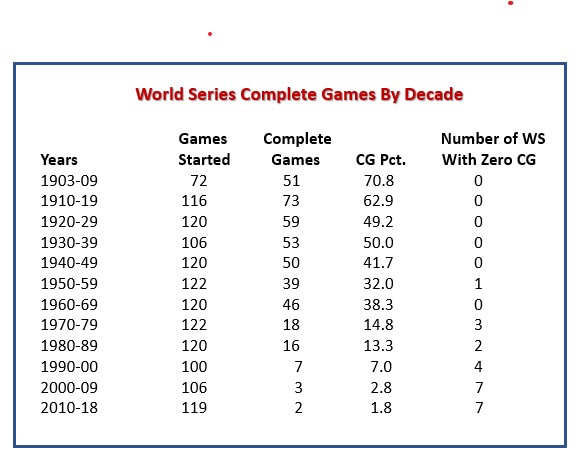 The “prelims” are over and we’ve got our match up for the Main Event – the Astros versus the Nationals in the World Series. As I contemplate the rosters of this pair of worthy opponents, I am led to wonder if, in the coming days, we will see that increasingly rare “unicorn” – a World Series complete game. After all, we are looking at some quality starting pitchers in Justin Verlander, Gerrit Cole and Zack Greinke on one hand and Max Scherzer, Stephen Strasburg and Patrick Corbin on the other. They have six Cy Young Awards among them – and, in 2019, this group won a combined 102 games (just 36 losses), put up a 2.75 earned run average and 1,547 strikeouts in 1,228 innings pitched.
The “prelims” are over and we’ve got our match up for the Main Event – the Astros versus the Nationals in the World Series. As I contemplate the rosters of this pair of worthy opponents, I am led to wonder if, in the coming days, we will see that increasingly rare “unicorn” – a World Series complete game. After all, we are looking at some quality starting pitchers in Justin Verlander, Gerrit Cole and Zack Greinke on one hand and Max Scherzer, Stephen Strasburg and Patrick Corbin on the other. They have six Cy Young Awards among them – and, in 2019, this group won a combined 102 games (just 36 losses), put up a 2.75 earned run average and 1,547 strikeouts in 1,228 innings pitched.
Still, they only tossed a total of three complete games in 2019 (two by Verlander and one by Corbin) and the era of the complete-game pitching performance does seem to have passed us by. If I had to pick the most likely source for a complete game in the upcoming Series, I go: 1) Justin Verlander (due to his two complete games this past season); 2) any one of the Nationals’ big-three starters (the Nationals’ MLB-worst 5.66 bullpen earned run average provides an incentive to let the starters go long). Still, I’m not optimistic about a nine-inning outing.
In this post, I’ll take a look at how the World Series has changed when it comes to complete games, as well as at a handful of pitchers who have the distinction of tossing three complete-game victories in a single World Series (under the current best-of-seven format).
But, first, the back story on why Fall Classic complete-games are of notable interest to me.
When the Braves moved from Boston to Milwaukee in 1953, I was a six-year-old Milwaukee native. My boyhood heroes made it to the World Series against the vaunted Yankees in 1957 – the first World Series I followed with a hometown passion. The hero of that Braves’ World Series Championship? Hank Aaron? Eddie Mathews? Warren Spahn? None of the aforementioned. Or looking to the other dugout, Mickey Mantle, Yogi Berra or Whitey Ford? Nope. It was Braves right-hander Lew Burdette, who earned three complete-game victories (two shutouts) in the Series – giving up a total of two earned runs in 27 innings. (More on Burdette later in this post.)
Fast forward to 1965 – and the first World Series I ever attended (Game Six). I was living in Minnesota by this time and rooting for the Twins to top the Dodgers. It wasn’t to be. The Dodger won four games-to-three. Notably, the winning pitcher in each game threw a complete game.
Now, jump ahead t0 1991, when I was in the stands when Jack Morris threw a ten-inning, complete-game shutout to top the Braves 1-0 in Game Seven – and give the Twins the championship.
So, there’s a bit of an explanation for my “old school” fascination with World Series’ complete-games.
While complete games in the Fall Classic have declined fairly steadily over the decades, the most notable drop began in the 1970. Consider that:
- The first World Series without at least one complete game didn’t occur until 1959 – and that was the only World Series without a complete game between 1903 and 1972;
- Since 1972, we’ve seen 23 World Series that did not have a single complete game;
- The most recent World Series complete game came on October 28, 2015 – when the Royals’ Johnny Cueto threw a nine-inning two-hitter (one runs, three walks, four strikeouts) in topping the Mets 7-1;
- Since 1996 (23 World Series, 129 games), there have been just three complete games (remember, old Lew Burdette had that many in one seven-game Series);
- The percentage of World Series starts ending in a complete game has dropped (by decade) from just over 70 percent in the 1900’s to just over 38 percent in the 1960’s to less than two percent thus far this decade.
Now, let’s move on to pitchers who have earned three complete-game victories in a best-of-seven World Series – and a couple of honorable mentions, which I think is better than an asterisk.
—PITCHERS WITH THREE COMPLETE-GAME VICTORIES
IN A BEST-OF-SEVEN WORLD SERIES—
Christy Mathewson, New York Giants … 1905 World Series
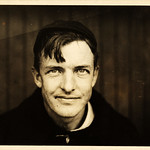
Photo by trialsanderrors 
It makes sense that a big name would head this list. The first pitcher to record three complete-game wins in a best-of-seven World Series was Hall of Famer Christy Mathewson.
By the time, Mathewson took the mound against the Athletics in the 1905 World Series, he was pretty much already a “Giant” in more ways than one. He had just completed his sixth MLB season (fifth full season) and had a 128-71, 2.08 career record. He had won 30 or more games in each of the past three seasons – leading the NL with 31 wins (9 losses), a 1.28 earned run average, eight shutouts and 206 strikeouts during the 1905 regular season.
All five games of the 1905 World Series featured a shutout by the winning team.
A great season for Mathewson, but even greater things were coming – as Mathewson was about to become the first (and still only) MLB pitcher to throw three complete-game SHUTOUTS in a single World Series.
In Game One (October 9), it was the Giants’ Mathewson versus 24-game winner Eddie Plank (also a future HOFer) in Philadelphia. Both starters went the distance, with Mathewson tossing a four-hit, no-walk, six-whiff shutout – and Plank giving up three runs on ten hits and two walks.
Game Two (October 10 in New York) ended by the same 3-0 score, this time with the Athletics on top – behind a complete-game, four-hitter from Chief Bender, another future Hall-of-Famer
On October 12, Mathewson was back on the bump for Game Three (in Philadelphia) and cruised to 9-0 win – tossing a second four-hitter (one walk/eight strikeouts), The Athletics left Andy Oakley (18-8, 1.84 on the season) in for the entire nine frames (only three of the nine runs he surrendered were earned, thanks to four Philadelphia errors).
Christy Mathewson played baseball, football and basketball for Bucknell University – and also was in the band, glee club and a pair of literary societies. A well-rounded fellow indeed.
Then it was back to New York for Game Five (October 13). Plank was back on the mound for the Athletics and once again got zero support – losing 1-0 (the only run unearned), as the Giants’ Joe McGinnity (another future Hall-of-Famer (tossed a five-hit shutout).
Mathewson won the final game (October 14) before a home crowd, beating the Athletics 2-0 – and tossing his third shutout in six days, this one a five-hitter (no walks/four strikeouts).
Mathewson went on to a 17-season MLB career, picking up 373 wins (188 losses). He led his league in victories four times and won 20 or more games 13 times (30+ four times). He also led his league in ERA five times; shutouts four times; strikeouts five times; complete games twice; and, retroactively, saves once.
Charles “Babe” Adams, Pittsburgh Pirates …. 1909 World Series
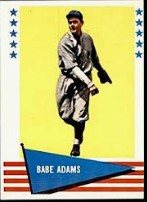 Babe Adams was still officially a rookie in 1909, when his Pittsburgh Pirates faced off against the Detroit Tigers in the World Series. (In 1906-07, he had appeared in a total of five MLB games – going 0-3, 7.96, with 26 innings pitched.)
Babe Adams was still officially a rookie in 1909, when his Pittsburgh Pirates faced off against the Detroit Tigers in the World Series. (In 1906-07, he had appeared in a total of five MLB games – going 0-3, 7.96, with 26 innings pitched.)
Adams debuted with the Cardinals, but was sold to the Pirates at the end of the 1907 season. He got in just four games for the Pirates as the season wore down and started (and finished) the 1908 season with the American Association Louisville Colonels. He flourished at Louisville – going 22-12 for the American Association Louisville Colonels in 1908. With Louisville he cemented a reputation for exceptional control, walking just 40 batters in 312 innings.
In 1909, Adams made it back to the big leagues. In his first full MLB season, he went 12-3, with a 1.11 earned run average in 25 games and 130 innings pitched (12 starts/seven complete games). The 5’ 11”, 185-pound, 27-year-old righty was a surprise starter in Game One of the Series, based on his exceptional control and strong finish to the season. (Moving from primarily a reliever to a starter in late August, Adams’ final eight appearances were starts and he went 4-2 with five complete games and two shutouts.)
In the opening game of the Series (October 8), Adams went the distance, tossing a six-hitter (one run, four walks and two strikeouts, as the Pirates prevailed (in Pittsburgh) 4-1. The Tigers bounced back to win Game Two (October 9) by a 7-2 score, knocking Pirates’ 25-game winner Howie Camnitz out of the game in the third inning.
Moving to Detroit, Pittsburgh won Game Three 8-6 and the Tigers took Game Four 5-0 – knotting the Series at two games apiece.
On October 13, Adams was back on the mound in Pittsburgh. Although not as effective as in Game One, Adams went the distance, giving up four runs (three earned) on six hits, while walking one and fanning eight. It was good enough for the win, as the Pirates plated eight runs.
On July 17, 1914, Babe Adams pitched a 21-inning, complete game – without issuing a single walk. It remains the longest walk-free complete game ever pitched. Unfortunately, Adams and his Pirates lost 3-1 to the Giants. Giant’s starter Rube Marquard also went the distance, giving up one run on 15 hits.
Detroit tied the Series at 3-3 with a 5-4 win on October 14, which set the stage for Adams’ best game of the Series. On October 16, he tossed a six-hit shutout (one walk/one whiff), as Pirates won the game and the Series by an 8-0 score.
Adams went on to a 19-season MLB career – putting up a 194-140, 2.76 record, completing 205 of 354 starts and walking just 430 batters in 2,995 1/3 innings. He won 15 or more games in five seasons and was a twenty-game winner twice.
Jack Coombs, Philadelphia Athletics … 1910 World Series
![[Jack Coombs, Brooklyn NL (baseball)] (LOC) by The Library of Congress Jack Coombs photo](https://baseballroundtable.com/wp-content/uploads/2019/10/14960294390_c575790e9b_q_Jack-Coombs.jpg)
Photo by The Library of Congress
He put it all together in that 1910 season, leading the AL with 31 wins (nine losses), as well as with 13 shutouts. He three 35 complete games in 38 starts and had a minuscule 1.30 ERA.
Now, you might have expected Coombs to draw the October 17 start (against the Cubs in Philadelphia) in Game One of the Series, particularly since the Athletics were without veteran started Eddie Plank (arm issues). Philadelphia chose to go with the more experienced Chief Bender (who himself had gone 23-5, 1.58 on the season) over Coombs – and the decision paid off. Bender shut down the Chicago squad, giving up one run (unearned) on three hits, with two walks and eight strikeouts. The following day, Coombs pitched the Athletics to a 9-3 win, giving up three runs on eight hits. It wasn’t exactly a sterling effort – as he also walked nine and had to pitch out of a lot of trouble.
The problems Coombs faced in Game Two didn’t seem to bother the Athletics, as Coombs was back on the mound (October 20 in Chicago) with just one day’s rest. It was another rocky – but successful – outing. Coombs surrendered three runs over the first three innings (scored tied at 3-3). Then the Athletics plated five in the top of the fourth and Coombs settled down. He went the distance again, giving up five runs on seven hits and four walks (eight strikeouts) in a 12-5 Philly victory. In this game, Coombs had three hits and three RBI of his own.
Bender went the distance in a losing effort in Game Four – falling 4-3 in ten innings.
It was back to Coombs for Game Five (October 23 in Chicago) and he finally turned in the kind of performance you’d expect from a pitcher with a season ERA south of 2.00. He gave up just two runs (although he did allow nine hits and a walk) in topping the Cubs 7-2. Notably, it was tense game, standing at 2-1 in Philadelphia’s favor until the Athletics explored for five runs in the top of the eighth.
To top off his three complete-games win, the switch-hitting Coombs went five-for-thirteen (.385) at the plate, with a double and three RBI.
Jack Coombs was an all-around athlete (and scholar). Before going to the major leagues, he earned a degree in chemistry from Colby College – where he was on the baseball, football, track and tennis teams.
Coombs pitched in 14 major league seasons, going 158-110, with a 2.78 ERA. In the three seasons from 1910 through 1912, he won 80 games (31 losses) and put up a 2.64 ERA, A bout with typhoid fever in in 1913 dampened his overall career stats. (Coombs pitched in only four games in 1913-15 and was 43-44, 3,29 from 1913 until his retirement in 1920.)
A Shout Out to a Near-Qualifier
Okay, let’s keep in mind that, from 1903 to the present day, the World Series has been a best-of-seven format in most seasons. The 1920 World Series, however, was a best-of-nine affair. Future Hall-of-Famer Stan Coveleski earned complete-game victories (for the Indians over the Brooklyn Robins) in Games One, Four and Seven. However, had the series been a best-of-seven, Game Seven would not have been played (the Indians went into the contest up four games-to-two.) Still, Coveleski deserve some attention here.,
Coveleski was six seasons into his 14-campaign Hall-of-Fame career when he threw his three complete-game wins in the 1920 World Series. He won 20+ games in each of three previous seasons and had gone 24-12, 2.49 in 1920.
In Game one of the Series (October 5 in Brooklyn), Coveleski earned a victory over Rube Marquard (another future HOFer), by a 3-1 score, tossing a nifty five-hitter (one walk/three strikeouts). Coveleski faced off against the Dodgers Leon Cadore in Game Four (October 9 in Cleveland), with the Indians down two games-to-one. He came through again, giving up just one run (five hits, one walk, four strikeouts) in a complete-game 5-1 win.
Coveleski’s number came up again on October 12 (Game Seven), with the Indians up four games-to-two. This time, he tossed a complete-game, five-hit shutout – topping the Robins and future Hall-of-Famer Burleigh Grimes 3-0.
Coveleski pitched in 14 MLB seasons, going 215-142, 2.89 – winning 20 or more games in five campaigns.,
Lew Burdette, Milwaukee Braves … 1957 World Series
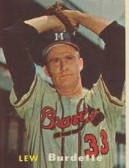 Pretty much everybody – except those of us in Milwaukee – figured the Yankees would top the Braves in the 1957 World Series. Consider, as the Series opened, in my lifetime (I was born in 1947), the Yankees had won nine AL pennants and seven World Series championships in eleven years. My Milwaukee Braves? They were the recently (1953) relocated Boston Braves. Enough said. It was Beertown versus the Big Apple. Few prognosticators gave the boys from Sudsville much of a chance.
Pretty much everybody – except those of us in Milwaukee – figured the Yankees would top the Braves in the 1957 World Series. Consider, as the Series opened, in my lifetime (I was born in 1947), the Yankees had won nine AL pennants and seven World Series championships in eleven years. My Milwaukee Braves? They were the recently (1953) relocated Boston Braves. Enough said. It was Beertown versus the Big Apple. Few prognosticators gave the boys from Sudsville much of a chance.
Prospects looked even dimmer when Braves’ ace (and future HOFer) Warren Spahn (who had led the NL in wins that season with 21 and already had eight seasons of 20 or more victories) lost to the Yankees and (future HOFer) Whitey Ford 3-1 in the opening game (in New York). Game Two matched the Yankees’ Bobby Shantz (11-5, with an AL-best 2.45 ERA) versus the Braves’ Lew Burdette (who had gone 17-9. 3.72 on the season).
Lew Burdette had originally signed with the Yankees and made his debut with the New York club in 1950 – pitching just 1 1/3 innings in two appearances. Remember the old “Spahn and Sain and pray for rain” refrain for the Boston Braves. Well, Burdette broke that up, being traded from the Yankees to the Braves (along with $50,00) for Johnny Sain in August of 1951.
In Game Two of the Series (October 3), Burdette stifled the Yankee attack, winning 4-2 and pitching a complete game, seven-hitter (three walks/five whiffs). As it turned out that would be the “worst” game of Burdette’s 1957 post-season.
Game Three (October 5) saw the teams move to Milwaukee, where the Yankees pasted the upstart Braves 12-3. Don Larsen got the win, Bob Buhl the loss. Spahn (21-11, 2.69) was matched against Tom Sturdivant (16-6, 2.54) in Game Four (October 6 in Milwaukee). Spahn went the distance in a 7-5 ten inning Braves’ win; with the winning blow a two-run home in the bottom of the tenth by Eddie Mathews.
With the series now tied at two games apiece, Game Five (October 7 in Milwaukee) saw Burdette having to face Yankees’ ace Whitey Ford. It was a duel for the ages. Burdette went the distance in a 1-0 win, giving up just seven Yankee safeties, walking no one and fanning five. Ford gave up one run on six hits and walk in seven innings – with the only run being scored by Mathews (on a Joe Adcock single in bottom of the sixth).
The Yankees evened the series in Game Six (October 9 in New York), edging the Brave 3-2 – setting up the finale (October 10), with Burdette (on two-day’s rest) facing Larsen. Burdette did not disappoint the Milwaukee fans. He threw his third complete game and second consecutive shutout of the Series – topping the Yankees 5-0 and giving up seven hits and one walk, while fanning three.
Burdette enjoyed an 18-season MLB career (203-144, 3.66). He was a two-time All Star and two-time twenty-game winner. He also led his league in wins once, ERA once, complete games once, and shutouts twice. His best season was 1958 (20-10, 2.91) – but his most notable accomplishment was bringing Milwaukee its first World Series Championship.
Bob Gibson, Cardinals, 1967 World Series
 It was the year before the Year of the Pitcher, but Bob Gibson was already an imposing presence on the mound – a f0ur-time All Star, with a 125-88, 3.12 record and a reputation for taking no prisoners. Further, despite suffering a broken leg in mid-July that put him out of action until early September, Gibson was the logical choice to start Game One of the 1967 Series. The fact is, he was tougher after the injury than before. When he went down (it was a Roberto Clemente line drive off his leg), Gibson was 10-6, 3.52. After returning from the fracture, Gibson went 4-1, with a microscopic 0.96 in five September starts. On the season, he was 13-7, 2.98. He was clearly ready.
It was the year before the Year of the Pitcher, but Bob Gibson was already an imposing presence on the mound – a f0ur-time All Star, with a 125-88, 3.12 record and a reputation for taking no prisoners. Further, despite suffering a broken leg in mid-July that put him out of action until early September, Gibson was the logical choice to start Game One of the 1967 Series. The fact is, he was tougher after the injury than before. When he went down (it was a Roberto Clemente line drive off his leg), Gibson was 10-6, 3.52. After returning from the fracture, Gibson went 4-1, with a microscopic 0.96 in five September starts. On the season, he was 13-7, 2.98. He was clearly ready.
Gibson proved his worthiness in Game One (October 4 in Boston), topping Jose Santiago and the Red Sox in a nail-biter. The final was 2-1 and Gibson threw a complete-game six-hitter, with one walk and ten strikeouts.
Gibson was back on the mound for Game Four (October 8 in St. Louis), with the Cardinals up two games-to-one. (Boston’s Jim Lonborg threw a nifty one-hit shutout in Game Two and the Redbirds came back to win 5-2 in Game Three.) In the fourth game, Gibson followed Lonborg’s lead, tossing complete-game shutout of his own (five hits, one walk, six strikeouts), as the Cardinals prevailed 6-0.
The Red Sox bounced back to win Game Six by an 8-4 score, setting up a match that fans had been waiting for – Gibson versus Lonborg in a winner-take-all Game Seven. Unfortunately, the anticipated pitching duel didn’t materialize. The Cardinals were up 4-1 after five frames and Gibson coasted to a 7-2 win, tossing his third complete game of the series (three hits, three walks, ten K’s).
Bob Gibson played college basketball for Creighton and spent a season with the Harlem Globetrotter before starting his baseball career.
Gibson made the Hall of Fame after a 17-season MLB career in which he was an All Star nine times and won 20 or more games five times. He led the NL in wins once; ERA once; complete games once; shutouts four times; and strikeouts once. He ended his career at 251-174, 2.91, with 3,117 strikeouts in 3,884 1/3 innings.
In 1968, the Year of the Pitcher, Bob Gibson went 22-9, with an MLB-best 1.12 ERA; MLB-tops 13 complete game shutouts; and an NL-best 268 strikeouts. He was the National League Cy Young Award winner and Most Valuable Player.
In June/July of that season, Gibson started 12 games, completed and won all 12, threw eight shutouts and put up a 0.50 ERA.
Mickey Lolich, Detroit Tigers … 1968 World Series
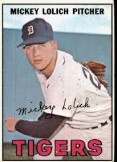 Like Lew Burdette earlier on this list, Mickey Lolich was not the “ace” of his staff. For Burdette (in 1957), of course, that was Warren Spahn. For Lolich, and the 1968 Tigers, that was Denny McLain, who was the Pitcher of the Year in The Year of the Pitcher – going 31-6, 1.96 and winning the AL Cy Young and MVP Awards. Lolich had been no slouch, going 17-9, 3.19; but clearly, the match up between the Cardinals’ Bob Gibson (who would win the Cy Young and MVP in the National League) and McLain was the pre-series choice as the main attraction.
Like Lew Burdette earlier on this list, Mickey Lolich was not the “ace” of his staff. For Burdette (in 1957), of course, that was Warren Spahn. For Lolich, and the 1968 Tigers, that was Denny McLain, who was the Pitcher of the Year in The Year of the Pitcher – going 31-6, 1.96 and winning the AL Cy Young and MVP Awards. Lolich had been no slouch, going 17-9, 3.19; but clearly, the match up between the Cardinals’ Bob Gibson (who would win the Cy Young and MVP in the National League) and McLain was the pre-series choice as the main attraction.
Gibson got the best of it in Game One, shutting out the Tigers (and beating McLain) in St. Louis by a 4-0 score (October 2). Game Two (October 3) featured Lolich versus the Redbirds’ Nelson Briles (19-11, 2.81) – and Lolich went the distance, throwing a complete-game six-hitter (two walks/nine whiffs) in an 8-1 win.
The Series moved to Detroit with the Cardinals taking Game Two (October 5) and Game Three (October 6) 10-1 in another Gibson/McLain match up.
Down three games to one, The Tigers went back to Lolich (again facing Briles) for Game Five (October 7 in Detroit). Lolich delivered his second complete-game win 5-3 (nine hits, one walk, eight strikeouts.) McLain finally sparkled in Game Six, as the Tigers tied the Series 3- 3 winning 13-1 behind McLain’s complete-game (one-run on nine hits, no walks, with seven strikeouts.)
Lolich got his third start of the Series in Game Seven (October 10 in St. Louis) and had his best outing of the Fall Classic – topping Gibson and the Cardinals 4-1 with a complete game five-hitter.
Lolich pitched 16 seasons in the major leagues, going 217-191, 3.44, with 2,832 strikeouts in 3,638 1/3 innings pitched. He was a three-time All Star and won 20+ games in a season twice. He led his league in wins once, complete games once, innings pitched once and strikeouts once. In 1971, he went 25-14, 2.92 with an AL-leading 308 strikeouts – but finished second in the Cy Young Award voting to Vida Blue 24-8, 1.92, 301 whiffs.
The 1903 World Series – Sixteen Starts, 13 Complete Games
When the Boston Pilgrims (AL) faced off against the Pittsburgh Pirates (NL) in the first-ever AL/NL World Series, the Fall Classic (not yet a classic) was a best-of nine affair. That first Series went eight games, with Boston winning five. In the process the MLB, AL and NL records for complete games in a single World Series (of any length) were set.
The Pirates’ Deacon Phillipe (25-9, 2.43) started and completed five games (in ten days), going 3-2, 2.86. Phillipe still holds the MLB and NL records for complete games in a single World Series. Boston’s Bill Dinneen (21-13, 2.26) set and still holds the AL record with four complete games (in four starts) – going 3-1, 2.06.
Cy Young, by the way, started and completed three games in the Series – going 2-1, 1-85.
Phillipe enjoyed a 13-season MLB career, compiling 189 wins (109 losses) and a 2.59 ERA. He won 20 or more games in five seasons, Dinneen’s MLB career lasted 12 seasons (170-177, 3.01) and he won 20 or more games in four campaigns.
Primary Resources: The World Series, Sports Products, Inc.; Baseball-Reference.com; ESPN.com
BASEBALL ROUNDTABLE ON THE TOP 100 BASEBALL BLOG LIST
 Baseball Roundtable is on the Feedspot list of the Top 100 Baseball Blogs. To see the full list, click here.
Baseball Roundtable is on the Feedspot list of the Top 100 Baseball Blogs. To see the full list, click here.
I tweet baseball @DavidBBRT
Follow/Like Baseball Roundtable’s Facebook Page here. More baseball commentary; blog post notifications; PRIZES.
Member: Society for American Baseball Research (SABR); The Baseball Reliquary; The Negro Leagues Baseball Museum.
